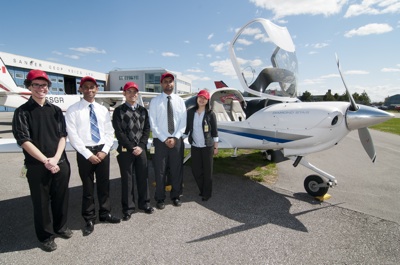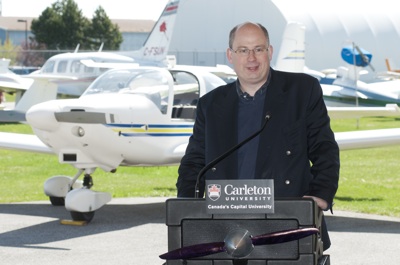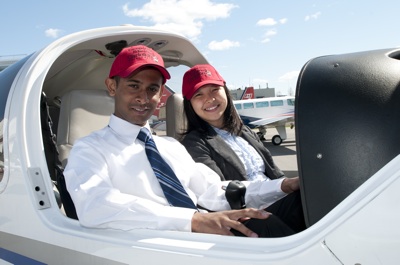
News
Carleton University to offer student ground-breaking opportunities
 May 11, 2011, Ottawa – Carleton University’s Department of Mechanical
and Aerospace Engineering, Ottawa Aviation Services (OAS) and B-Con
Engineering (B-Con) announced that they have entered into a new
partnership that will offer Carleton aerospace engineering students
ground-breaking opportunities.
May 11, 2011, Ottawa – Carleton University’s Department of Mechanical
and Aerospace Engineering, Ottawa Aviation Services (OAS) and B-Con
Engineering (B-Con) announced that they have entered into a new
partnership that will offer Carleton aerospace engineering students
ground-breaking opportunities.
May 11, 2011 By Melissa Damota
May 11, 2011, Ottawa – Carleton University’s Department of Mechanical and Aerospace Engineering, Ottawa Aviation Services (OAS) and B-Con Engineering (B-Con) announced that they have entered into a new partnership that will offer Carleton aerospace engineering students ground-breaking opportunities.
Initiatives include:
- An innovative co-op engineering and professional pilot-training program for students
- An advanced simulator technology partnership
- A research project to anticipate problems and then repair the structure of modern aircraft
Innovative Co-op Engineering and Professional Pilot Training Program
“This innovative program, the first of its kind in Canada, brings together the strengths of Carleton and OAS in teaching and training aeronautical skills to offer an incredible education experience for our students,” said Metin Yaras, chair of Carleton Department of Mechanical and Aerospace Engineering. “Combining their engineering education with the practical flying experience that they will gain through this co-op program will give our students a competitive advantage when entering the workforce because they will understand the flying environment from both an engineer’s and a pilot’s perspective.”
| {youtube}8oa9PqXbIio|400|300{/youtube} |
|
|
The partnership provides Carleton engineering students with 15 placements each year to obtain either a commercial pilot’s license or a private pilot’s license to complement their engineering degree. Seven of these placements are open to aerospace engineering co-op students.
The new partnership welcomed its first students on May 4. OAS co-op students also have the opportunity to be trained as dispatchers, safety management system and quality auditors, maintenance technicians or aviation administrators while receiving hands-on pilot training. They will graduate with a Bachelor of Aerospace Engineering, as well as obtaining a pilot’s licence with multi-engine and instrument flight rules (IFR) ratings.
 |
| From L-R: Carleton University co-op aerospace engineering students Nicholas Ogrodnik, Jathunath Thiyagalingam, Lambros Fernandes, Allister D’Silva and Indira Mukasheva. (Photo by James Park)
|
Advanced Simulator Technology Partnership
“This partnership reflects a major development in pilot training as universities are now connecting directly to provide the best-trained pilots to operators and more experienced engineers to the industry,” said Cedric Paillard, co-owner of OAS.
In the mid-1990s, OAS broke the flight-training mould by introducing Diamond’s Katana aircraft into Canada. Now the progressively-minded school has introduced ab-initio flight simulation as part of its standard curriculum. Last year, the company invested in a Mechtronix Ascent® Turboprop Trainer™. This year, in partnership with Carleton and B-Con Engineering, a local advanced optical design and manufacturing firm, Carleton aerospace students will have an opportunity to work with Carleton Engineering Professor Rob Langlois to transform an OAS-owned Katana Diamond aircraft into a flight simulator. They will create an immersive, more realistic and cost-effective visual system.
 |
| Cedric Paillard, co-owner of OAS. (Photo by James Park)
|
Says Langlois: “This will build on research work that we have been doing at Carleton since 2002 and will provide yet another ‘anything but textbook’ experience for our students.”
B-Con’s existing technologies in the area of spherical-projected display will also contribute to the Carleton University Simulator Project (CUSP) by allowing the projection of images onto non-flat surfaces such as the spherical dimensions of the CUSP simulator cockpit, or alternatively an aircraft cockpit, while keeping depth perspective intact. The technology will first be demonstrated on the OAS Katana simulator and then applied to CUSP before being offered to the simulator industry for implementation in commercial applications. “B-Con will then be able to offer a cost-effective visual solution to the simulator industry allowing flight schools like OAS to better train pilots,” said Paillard.
 |
| Two Carleton U aerospace students, Indira Mukasheva (right) and Jathunath Thiyagalingam (left). (Photo by James Park)
|
The three partners are working on the visual and motion solutions that may form the base technology for the next generation of flight simulators. “We’re excited to partner with Carleton’s CUSP project and the OAS Katana simulator as they are the perfect vehicle to demonstrate our optical technology,” shares Brian Creber, president of B-Con Engineering. One of the applications of the CUSP simulator, with its expanded range of motion and enhanced visual solution, is to provide better unusual attitude and upset recovery training for pilots.
For years, Langlois and other Carleton researchers working on the CUSP project have exposed engineering students to the latest simulator technology. Now, students are combining their work on the CUSP project with the “real-world” need to provide a more immersive and better visual solution to flight simulator companies. Mechtronix already generously supports the training of engineers for Canada’s world-leading simulator industry through longtime involvement with CUSP.
Mechtronix President Xavier Hervé said: “We have a long history of supporting initiatives like the partnership between Carleton University, OAS and B-con Engineering and we think it is very important to actively support projects like CUSP that promote the aviation industry by developing innovative training solutions for pilot students in Canada.” CUSP is one of several capstone design projects that allow students to develop industrial project skills while working on innovative technologies, in this case a simulator providing a vastly-expanded motion envelope.
Final-year engineering student Joel Spark has been working on the CUSP project for the past year. “The OAS Katana simulator, B-Con Engineering advanced visual systems and CUSP are the perfect combination and opportunity to apply the aerospace knowledge we have gained at Carleton and demonstrate it to potential employers. It’s collaborative projects like these that make Carleton uniquely appealing to students.”
Research project to anticipate problems and then repair the structure of modern aircraft
Discussions are also underway between Carleton and OAS to set up a research program for proactive composites maintenance for general aviation aircraft, including low-cost structural health monitoring, design of repairs and loads monitoring. Under this partnership, students will be trained to repair OAS’s modern composite aircraft fleet. Carleton and OAS will also be sharing equipment and facilities as well as training. “Composite airplanes are the future as they are lighter, cost less to manufacture and use less fuel,” said Yaras.
Carleton created the first BEng in Aerospace Engineering in Canada and continues to offer leading-edge programs in this field in partnership with local high tech companies including B-Con Engineering and Ottawa Aviation Services.